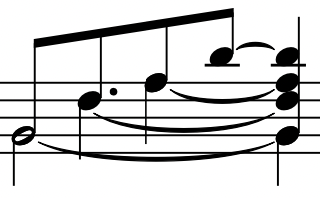A broken chord like this is notated with double stems for each note. One set of stems corresponds to the eighth-note onsets of each notepitch. The second set of stems corresponds to the duration of each notepitch and shows the tie to the final, full chord.
It is acceptable to use shared note heads in this kind of situation. For example, the first note could have a half-note head, but an eighth-note stem.
Here is a similar example from the left hand, final two measures of Brahms's "Intermezzo" Op. 119, No. 2. Note here that Brahms clearly expects the fingers to sustain the pitches. The pedal marking is not for the sustain, but rather for the "warmth" of the overall sound.
A second example, from Chopin, shows the importance of the ties versus a simple pedal indication.1
This first image is the first four measures of Chopin's Prelude in C major, Op. 28, No. 1, from the Paderewski edition (i.e., this is Paderewski's interpretation of how this should be played). Note the one-pedal-per-measure scheme, which is marked "Ped. simile" ("keep pedaling in the same way") in the fourth measure.
However, this notation clearly does not mean to hold all notes of the chords. The sound would be extremely muddy. Consider this notation isin light of the final three measures (mm. 32–34), shown below. Measure 32 is played as shown in mm. 1–4, but measures 33 and 34 are explicitly tied to illustrate the intention of a slowly arpeggiated block chord. (Also, the absence of double note heads is another alternative notation that is sometimes used.)





